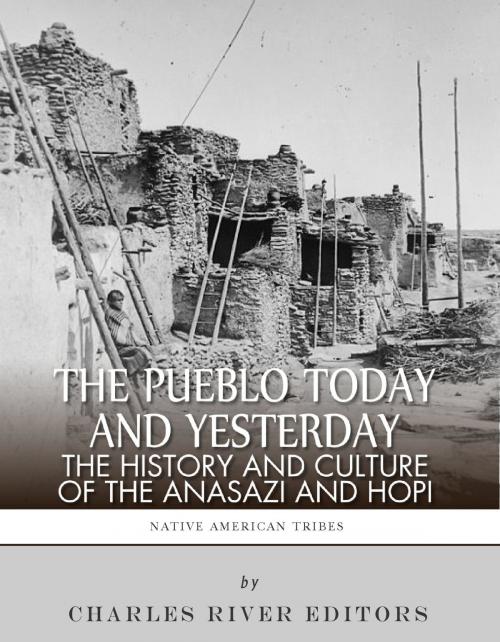The Pueblo of Yesterday and Today: The History and Culture of the Anasazi and Hopi
Nonfiction, History, Americas, Native American, United States| Author: | Charles River Editors | ISBN: | 9781475323924 |
| Publisher: | Charles River Editors | Publication: | June 7, 2013 |
| Imprint: | Language: | English |
| Author: | Charles River Editors |
| ISBN: | 9781475323924 |
| Publisher: | Charles River Editors |
| Publication: | June 7, 2013 |
| Imprint: | |
| Language: | English |
*Includes pictures of art, artifacts, ruins, and more. *Explains the origins, history, religion, and social structure of the Ancient Pueblo and the Hopi*Includes a Bibliography for further reading.*Includes a Table of Contents.When European settlers and later American settlers came into contact with Native American tribes on the continent, they were frequently unable to differentiate between the subcultures within individual tribes, leading to all kinds of misunderstandings. When the Spanish came into contact with different tribes in the Southwest, they categorized several of them as Pueblo. Thus, while most Americans have heard of the Pueblo and Navajo, many remain unfamiliar with distinctions within the tribes. The Pueblo fascinated those who came across their settlements, especially those located in desert regions and the sides of cliffs that involved the use of adobe mud, stone, carving homes out of cliffs. One such settlement, Oraibi, was created around 1100 A.D. and remains one of the oldest continuously inhabited settlements in North America. The Spanish were so intrigued by the structure of the communities that they gave the natives the name Pueblo, a term they used to measure certain sizes for their own settlements.Todays Puebloan tribes are descended from tribes known as the “Ancestral Puebloan People”, one of which was the Anasazi. The name Anasazi came from their enemies; it is a Navajo word that means “enemy ancestor”. While that name understandably continues to offend the descendants of the Anasazi, it also underscores that there is still a lot of uncertainty regarding the history of the Anasazi. It is still unclear what the Anasazi called themselves, and though they resided near the “Four Corners” area of Utah, Arizona, Colorado and New Mexico for more than 700 years, they mysteriously abandoned their settlements shortly after they truly began to flourish around 1050-1150 A.D. Despite the unknowns, it is likely that all of the Puebloan tribes today are at least partially descended from the Anasazi,including the Hopi. Occupying a large portion of what is essentially the Navajo Nation Reservation, spanning Navajo and Coconino Counties on the edge of the Painted Desert, the Hopi (Ho-pee, a shortened form of Hopituh-Shi-nu-mu, meaning "peaceful people") are the westernmost of the Pueblo Native American groups. Perhaps most importantly, the location of the Hopi, and all the contact between them and European settlers, have helped create a thorough understanding of their culture. Explorers and anthropologists who came to Oraibi also learned enough about the culture there to come to understand the links between the Hopi and other tribes. While they ultimately suffered a similar fate to other tribes and were settled onto a reservation, there are still over 10,000 Hopi today, and their history continues to fascinate researchers.The Pueblo of Yesterday and Today comprehensively covers the culture and history of the Pueblo, profiling their origins, their way of life, their famous leaders, and their lasting legacy. Along with pictures of important people, places, and events, you will learn about the Anasazi and Hopi like never before.
*Includes pictures of art, artifacts, ruins, and more. *Explains the origins, history, religion, and social structure of the Ancient Pueblo and the Hopi*Includes a Bibliography for further reading.*Includes a Table of Contents.When European settlers and later American settlers came into contact with Native American tribes on the continent, they were frequently unable to differentiate between the subcultures within individual tribes, leading to all kinds of misunderstandings. When the Spanish came into contact with different tribes in the Southwest, they categorized several of them as Pueblo. Thus, while most Americans have heard of the Pueblo and Navajo, many remain unfamiliar with distinctions within the tribes. The Pueblo fascinated those who came across their settlements, especially those located in desert regions and the sides of cliffs that involved the use of adobe mud, stone, carving homes out of cliffs. One such settlement, Oraibi, was created around 1100 A.D. and remains one of the oldest continuously inhabited settlements in North America. The Spanish were so intrigued by the structure of the communities that they gave the natives the name Pueblo, a term they used to measure certain sizes for their own settlements.Todays Puebloan tribes are descended from tribes known as the “Ancestral Puebloan People”, one of which was the Anasazi. The name Anasazi came from their enemies; it is a Navajo word that means “enemy ancestor”. While that name understandably continues to offend the descendants of the Anasazi, it also underscores that there is still a lot of uncertainty regarding the history of the Anasazi. It is still unclear what the Anasazi called themselves, and though they resided near the “Four Corners” area of Utah, Arizona, Colorado and New Mexico for more than 700 years, they mysteriously abandoned their settlements shortly after they truly began to flourish around 1050-1150 A.D. Despite the unknowns, it is likely that all of the Puebloan tribes today are at least partially descended from the Anasazi,including the Hopi. Occupying a large portion of what is essentially the Navajo Nation Reservation, spanning Navajo and Coconino Counties on the edge of the Painted Desert, the Hopi (Ho-pee, a shortened form of Hopituh-Shi-nu-mu, meaning "peaceful people") are the westernmost of the Pueblo Native American groups. Perhaps most importantly, the location of the Hopi, and all the contact between them and European settlers, have helped create a thorough understanding of their culture. Explorers and anthropologists who came to Oraibi also learned enough about the culture there to come to understand the links between the Hopi and other tribes. While they ultimately suffered a similar fate to other tribes and were settled onto a reservation, there are still over 10,000 Hopi today, and their history continues to fascinate researchers.The Pueblo of Yesterday and Today comprehensively covers the culture and history of the Pueblo, profiling their origins, their way of life, their famous leaders, and their lasting legacy. Along with pictures of important people, places, and events, you will learn about the Anasazi and Hopi like never before.















